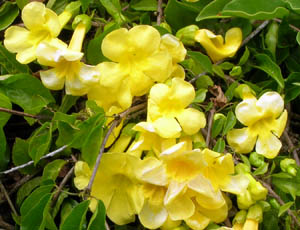This fact sheet provides basic information about  the herb cat’s claw—common names, uses, potential side effects, and resources for more information. Cat’s claw grows wild in many countries of Central and South America, especially in the Amazon rainforest.
the herb cat’s claw—common names, uses, potential side effects, and resources for more information. Cat’s claw grows wild in many countries of Central and South America, especially in the Amazon rainforest.
Common Names—cat’s claw, uña de gato
Latin Names—Uncaria tomentosa, Uncaria guianensis
What It Is Used For
• Cat’s claw has been used for centuries in South America to prevent and treat disease.
• It has been used for a variety of health conditions, including viral infections (such as herpes and HIV), Alzheimer’s disease, cancer, and arthritis.
• Cat’s claw has been used to support the immune system and promote kidney health, as well as to prevent and abort pregnancy.
How It Is Used
The inner bark of cat’s claw is used to make liquid extracts, capsules, and teas. Preparations of cat’s claw can also be applied to the skin.
What the Science Says
• There is not enough scientific evidence to determine how well cat’s claw works for any health problem, including arthritis, HIV, or cancer.
• Small studies in humans have shown a possible benefit of cat’s claw in osteoarthritis and rheumatoid arthritis, but no large trials have been done. In laboratory studies, cat’s claw stimulates part of the immune system, but it has not been proven to reduce inflammation or boost the immune system in humans.
• The National Institute on Aging is studying how cat’s claw may affect the brain. Findings may point to new avenues for research in Alzheimer’s disease treatment.
Side Effects and Cautions
• Few side effects have been reported for cat’s claw when it is taken at recommended dosages. Though rare, side effects may include headaches, dizziness, and vomiting.
• Women who are pregnant or trying to become pregnant should avoid using cat’s claw because of its past use for preventing and aborting pregnancy.
• Because cat’s claw may stimulate the immune system, it is unclear whether the herb is safe for people with conditions affecting the immune system.
• Tell your health care providers about any complementary and alternative practices you use. Give them a full picture of what you do to manage your health. This will help ensure coordinated and safe care.
Sources
Cat’s claw. Natural Medicines Comprehensive Database Web site. Accessed at http://www.naturaldatabase.com on November 22, 2006.
Cat’s claw (Uncaria tomentosa, Uncaria guianensis). Natural Standard Database Web site. Accessed at http://www.naturalstandard.com on November 22, 2006.
This publication is not copyrighted and is in the public domain. Duplication is encouraged. NCCAM has provided this material for your information. It is not intended to substitute for the medical expertise and advice of your primary health care provider. We encourage you to discuss any decisions about treatment or care with your health care provider. The mention of any product, service, or therapy is not an endorsement by NCCAM. National Institutes of Health.









+ There are no comments
Add yours